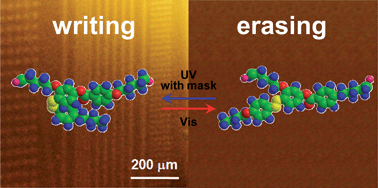Reversible actuating and writing behaviours of a head-to-side connected main-chain photochromic liquid crystalline polymer
Abstract
A photochromic liquid crystalline (

* Corresponding authors
a
Department of Polymer-Nano Science and Technology and Department of Flexible and Printable Electronics and Department of BIN Fusion Technology, Chonbuk National University, Jeonju, Korea
E-mail:
kujeong@jbnu.ac.kr, mhlee2@jbnu.ac.kr
Fax: +82 63 270 2341
Tel: +82 63 270 4633
b Liquid Crystal Institute, Kent State University, Kent, OH 44242, USA
A photochromic liquid crystalline (

 Please wait while we load your content...
Something went wrong. Try again?
Please wait while we load your content...
Something went wrong. Try again?
D. Kim, S. Lee, H. J. Choi, L. Chien, M. Lee and K. Jeong, J. Mater. Chem. C, 2013, 1, 1375 DOI: 10.1039/C2TC00506A
To request permission to reproduce material from this article, please go to the Copyright Clearance Center request page.
If you are an author contributing to an RSC publication, you do not need to request permission provided correct acknowledgement is given.
If you are the author of this article, you do not need to request permission to reproduce figures and diagrams provided correct acknowledgement is given. If you want to reproduce the whole article in a third-party publication (excluding your thesis/dissertation for which permission is not required) please go to the Copyright Clearance Center request page.
Read more about how to correctly acknowledge RSC content.
 Fetching data from CrossRef.
Fetching data from CrossRef.
This may take some time to load.
Loading related content
